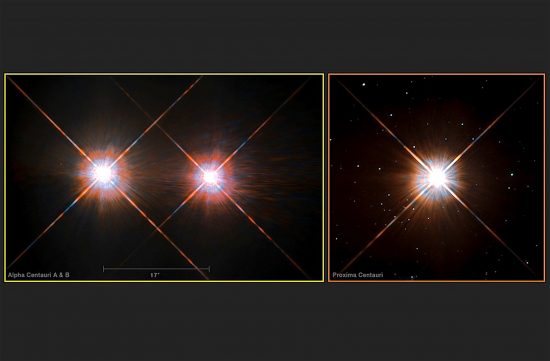
The binary system of Alpha Centauri (left) and their distant third sibling, Proxima Centauri. Credit: Y. Beletsky (LCO)/ESO/ESA/NASA/M. Zamani
Jun 27, 2018
Why are stars so unalike?
“If everyone is thinking alike, then somebody isn’t thinking.”
— George S. Patton
It is a mystery to astronomers why stars exhibit such distinctive characteristics, because the stars, including the Sun, are thought to form from the same mix of elements in a nebular cloud, or “protoplanetary disk”. It is thought by consensus astronomers that the Universe was created out of the largest structures imaginable: tremendous clouds and sheets containing millions of proto-galaxies that subsequently became smaller, which then evolved into individual galaxies.
According to present understanding, it is thought that the Milky Way galaxy condensed out of a cloud of hydrogen and dust thousands of light-years in extent, with a more-or-less homogeneous blend throughout; only minor variations existed. Hydrogen, helium, and some trace elements organized into a great whirlpool-like structure that is currently thought to contain almost a trillion stars. When the stars near the Sun are examined, they reveal the same variability among them, even though they are all considered to be siblings.
The twenty stars closest to the Sun in light-years are:
Proxima Centauri 4.2
Rigil Kentaurus 4.3
Alpha Cen B 4.3
Barnard’s Star 6.0
Wolf 359 7.7
BD +36 2147 8.2
Luyten 726-8A 8.4
Luyten 726-8B 8.4
Sirius A 8.6
Sirius B 8.6
Ross 154 9.4
Ross 248 10.4
Ross 128 10.9
61 Cyg A 11.1
61 Cyg B 11.1
Epsilon Ind 11.2
BD +43 44 A 11.2
BD +43 44 B 11.2
Luyten 789-6 11.2
Procyon A 11.4
Procyon B 11.4
BD +59 1915 A 11.6
BD +59 1915 B 11.6
CoD -36 15693 11.7
Each star is different from the Sun and from each other. Ross 248, for instance, is a red dwarf star, while Sirius A is a main sequence star two times the Sun’s mass. Although a few other stars in the list are red dwarfs, like Proxima Centaur, they are each unique in their spectral signatures. Various elements are not distributed in the same way as in the other spectrograms.
Since the initial proto-galactic cloud was undifferentiated overall, other stars near the Sun should all be cut from the same cloth and contain similar chemical constituents. Surveys out to hundreds of light-years, encompassing the nearest 6000 stars, reveal that they are all different from one another: some with more helium than their ages will allow, some with more iron than they should have, and other compositional oddities.
Stars are conventionally thought to mature according to a well-established process. Hydrogen fusion reactions create ever heavier elements, until the nuclear fuel is exhausted through radiative output, whereupon the star implodes, throwing off its outer layers. Therefore, a star’s age is theoretically determined by temperature and luminosity. The Sun’s stellar companions are all thought to be different ages. In fact, their ages are said to vary so much that astronomers think they were not even born in the same place or at the same time.
Their proposal is that the Milky Way’s spiral arms appear and disappear as it changes over the eons. Stars like the Sun take about 240 million years to orbit the center of the galaxy, and during that time it might feel a push or a pull from one or another of the arms. If a spiral arm is ahead of the Sun at a close enough distance, then it might impart a gravitational pull, accelerating it into a higher, more elongated orbit farther away from the galactic center. Conversely, if the Sun travels ahead of a spiral arm, it might be pulled from behind into a lower orbit.
Previous Picture of the Day articles argue against stellar evolution due to accretion and gravity-only models of compaction; thermonuclear furnaces in stellar cores; age-relevant data compiled from stellar brightness and color; and gravitational acceleration by congregations of loose-knit spiral arms. All such conventional ideas are contradicted by an electric explanation.
It is plain that astronomers are not mapping the electric charge flowing through space in order to determine its influence on stellar evolution. Because of that oversight, they constantly overstate the gravitational model of the cosmos.
Retired Professor of Electrical engineering Dr. Donald Scott wrote that the absolute brightness of a star depends on the strength of the current density impinging into its surface, along with the star’s diameter. As current density increases, a star becomes hotter and brighter, glowing bluer and whiter. If the current flow into the star decreases, a star becomes red and cools down. So using magnitude and color to determine a star’s age is a false premise.
In plasma cosmology and cosmogony, stars are created in galaxy-spanning Birkeland currents. Such currents actually draw charged material along their filaments from vast distances. As two (or more) filaments begin to twist around one another because of the long-range attractive force, the z-pinch effect crushes the interstellar plasma into galaxy-shaped masses.
In consideration of the work done by Wal Thornhill, Donald Scott, and Anthony Peratt, variations in stellar chemistry, as well as their velocity differences, are explained by a plasma hypothesis. It is the electrical forces active in space and not the gravitational shuffling of locations that causes differences among the stars.
Stephen Smith












